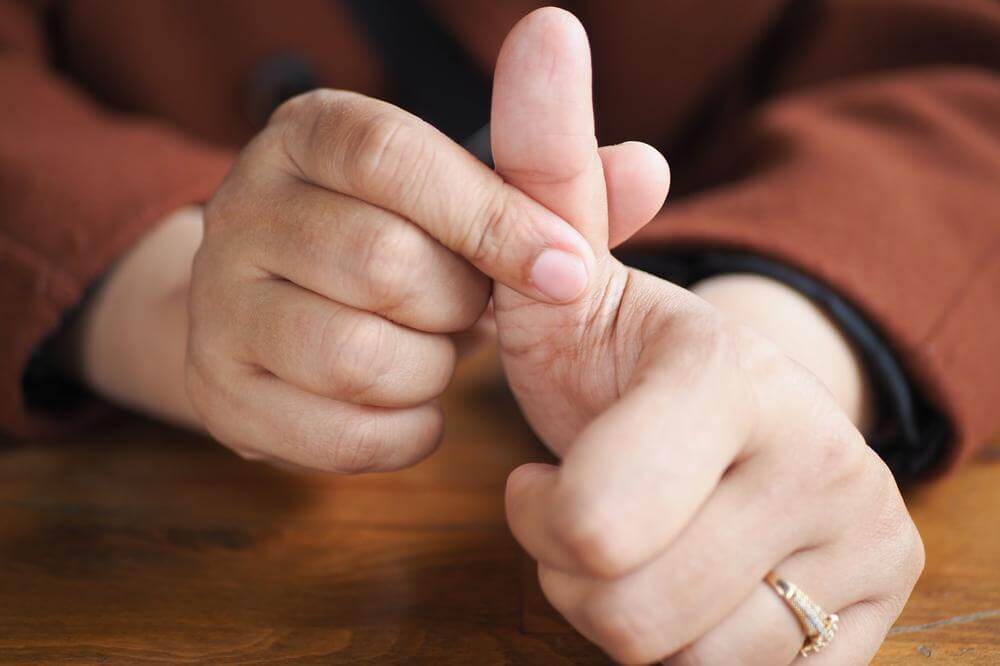The top 4 conditions that may be behind the pain in your thumb joint

Experiencing chronic pain around the joint in your thumb? Thumb joint pain can be difficult to deal with, especially when it starts to impact your daily activities. With persistent pain in the thumb joint, even simple tasks like grasping a doorknob or holding a TV remote can be challenging.
Thumb joint pain can have a lot of causes. From sudden sports or work injuries to gradually developing chronic conditions, there may be a number of factors playing a role in your pain. Learning more about the most common conditions behind thumb pain can help you get a better idea of what might be affecting you. When it comes to addressing thumb pain, physical therapy is a beneficial treatment route. A physical therapist can offer a range of solutions to help you find long-term pain relief. By learning more about your condition, you can play a more active part in your PT treatment.
Painful thumb joint and other related symptoms
Depending on the condition behind your joint pain, you might experience other symptoms as well. Thumb joint pain often develops alongside other symptoms localized around the same area. You may also experience symptoms that do not initially seem connected but may ultimately be caused by the same condition. Identifying your symptoms might help you find clues about the underlying issue causing your pain.
Swelling and stiffness are some of the most common symptoms that accompany thumb joint pain. If you notice sudden swelling and pain around your thumb, your symptoms may be signs of a recent injury. Some chronic joint conditions can also lead to swelling and stiffness, though. Other symptoms to look out for include numbness, tingling and weakness. If you are experiencing these symptoms along with thumb pain, the cause might be a nerve condition. Specifically, you might have peripheral neuropathy. Peripheral neuropathy means nerve damage that occurs outside the central nervous system. The central nervous system consists of the brain and spinal column, but nerve issues are not limited to these areas. Nerve damage that occurs in your hand or wrist can lead to pain and other symptoms in the thumb.
Want to get an accurate idea of your underlying condition? A physical therapist can help pinpoint your condition with a thorough assessment. After identifying your condition, your physical therapist can offer specialized treatment. Learning more about conditions that cause joint pain can help you understand what PT treatment might entail.
Common conditions that can cause thumb joint pain
- Sprained thumb — Twisted your thumb? A thumb sprain might be the reason for your joint pain. A sprain happens when a ligament is suddenly twisted, stretching it too far or even causing a tear. Ligaments are cords of strong tissue that work to keep your bones and joints connected. Because ligaments play a vital role in stabilizing your joints, a sprain can lead to joint issues. If you have sprained your thumb, the nearby joints might become irritated and cause some pain. A physical therapist can help you implement pain relief and healing techniques to recover from your sprained thumb.
- Arthritis — Arthritis refers to a set of conditions that involve inflammation in the joints. If you are experiencing persistent swelling and pain around your thumb joint, arthritis could be the cause. There are several different kinds of arthritis. While they all affect the joints, each kind of arthritis has some unique signifiers. Two of the most common kinds of arthritis are osteoarthritis and rheumatoid arthritis. Osteoarthritis is a degenerative condition involving the deterioration of cartilage. As the condition reduces the amount of cartilage between your bones, your bones and joints end up bearing more stress. This can lead to irritation and pain around your joints. Rheumatoid arthritis also causes joint irritation, but does so in a different way. Rheumatoid arthritis is an autoimmune condition characterized by the immune system attacking the body. In addition to joint pain, you may also experience swelling, tenderness and chronic fatigue. If you have arthritis, physical therapy can be crucial to managing your symptoms.
- Carpal tunnel syndrome — Carpal tunnel syndrome (CTS) is one of the most common neuropathies. In fact, studies show that CTS constitutes 90% of all neuropathy cases. CTS occurs when the medial nerve that runs through the carpal tunnel in the wrist is compressed. Tingling, numbness and weakness may accompany radiating pain throughout the hand and wrist. While CTS pain is not typically limited to the thumb, it can cause chronic pain around the thumb joint in addition to other symptoms. A physical therapist can help you apply management techniques to relieve your pain and improve your hand’s functionality.
- Overuse injury — Do you put a lot of stress on your thumb with strenuous repetitive motions? If so, the cause of your joint pain may be overuse. This kind of injury is typically referred to as a repetitive strain injury. When a repetitive strain injury occurs in the thumb, it is sometimes called “texting thumb” because the repetitive thumb motions involved in texting are a common culprit. If your thumb pain is caused by overuse, your physical therapist can help you adjust your movements to put less stress on your thumb. PT can also help you find pain relief and improve your overall joint health.
How to relieve thumb joint pain: 2 PT methods
- PT exercises — Targeted physical therapy exercises can be a great source of pain relief. With the right stretches and strengthening workouts, you can work to improve your thumb’s condition. The most effective PT exercises for you will depend on your particular condition and symptoms. After assessing your situation, your physical therapist can work with you to develop a tailored exercise regimen. Stretches can help improve your flexibility, reduce tension and increase your range of motion. If your thumb is stiff or swollen, focused PT stretches can be very helpful. Strengthening exercises can help by improving joint stability and grip strength. If you are recovering from an injury that caused weakness in your fingers, strengthening exercises can be essential.
- Manual therapy — Manual therapy refers to hands-on physical therapy treatments. An expert physical therapist can apply a range of manual techniques. Joint mobilization is one of the central methods. With this technique, your physical therapist will apply gentle pressure to help a stiff or painful joint get in motion. When it comes to addressing thumb joint pain, joint mobilization can be an effective technique. Your therapist may also use other manual therapy techniques to help you find lasting relief.
How painful is thumb joint replacement?
When other treatments are not effective, surgery is sometimes necessary. When it comes to addressing thumb joint issues, one of the most common operations is thumb arthroplasty. This is a procedure where the thumb joint is replaced. If you’ve been recommended for thumb joint replacement, you may be concerned about the effects of the surgery itself.
The level of pain associated with thumb arthroplasty can vary from person to person. In general, people tend to experience mild to moderate pain for a period of time after the surgery. This pain might be accompanied by swelling and discomfort. To minimize the negative effects of your surgery, post-surgical rehab can be essential. Rehabilitative treatment can help you find relief from your symptoms as you work toward recovery.
Find relief from your thumb pain at the joint with treatment from Franklin Rehabilitation
Ready to address your thumb pain? Franklin Rehabilitation is here to help. With our expert guidance and comprehensive treatment options, we are committed to providing the care you need to alleviate your discomfort.
Call us or request an appointment today for pain relief and effective healing treatments.
